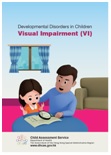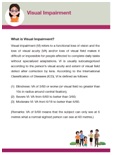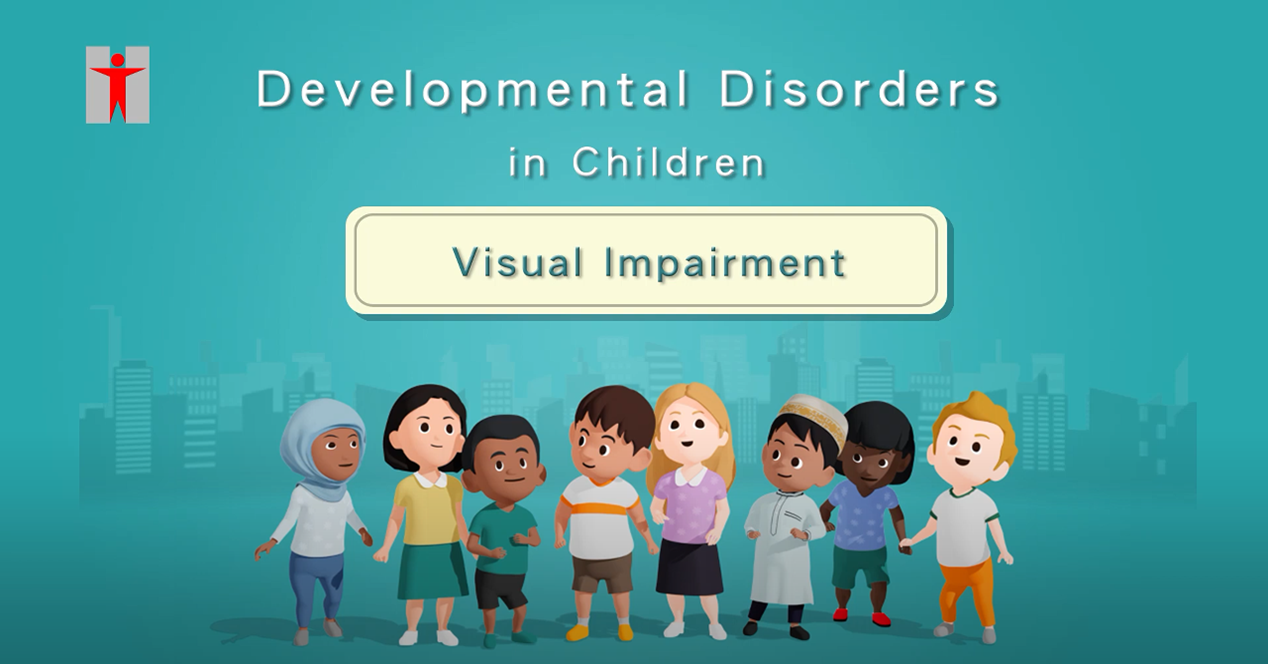Visual Impairment
Visual impairment (VI) refers to a functional loss of vision and the loss of visual acuity (VA) and/or loss of visual field makes it difficult or impossible for people affected to complete daily tasks without specialized adaptations. VI is usually subcategorized according to the person’s visual acuity and extent of visual field defect after correction by lens. According to the International Classification of Diseases (ICD), VI is defined as follows:
- Blindness: VA of 3/60 or worse (or visual field no greater than 10o in radius around central fixation);
- Severe VI: VA from 6/60 to better than 3/60;
- Moderate VI: VA from 6/18 to better than 6/60.
(Remarks: VA of 6/60 means that the subject can only see at 6 metres what a normal sighted person can see at 60 metres.)
Children with VI may have problems of reduced visual acuity for near and distant objects. They may not see others’ faces and bodies clearly. They show poor eye contact, lack of facial expression and body language. Because of poor vision, they may not show interest for even big and moving toys which are placed close to their eyes and they will look at the objects at a very close distance. On the other hand, they show different responses to bright light. They may prefer to gaze at light or may avoid looking at it. Some children with blindness do not blink to bright light, while others may poke their eyes for self-stimulation.
Mobility:
When children cannot see the environment or surroundings clearly, they become hesitated to move around and, hence, it is more difficult for them in learning to walk. When they move around, they always needed to use their hands and feet to explore the environment, as well as to orientate themselves and stay away from obstacles on their way. With training and accumulated experience, they can also manage to grasp environment circumstances through sound, smell, vestibular, proprioceptive sensation or some devices (such as mobility canes) and thus improve their ability to get around.
Hand function:
VI will lead to poor eye-hand coordination which affects fine motor development. These children often have to rely on other senses, including auditory, tactile, vestibular, proprioceptive, olfactory and gustatory, for information and learning. Children with VI often exhibit tactile defensiveness and fear of movement, which further hinder their activities in daily living.
Language and communication:
VI affects language development in infants and young children. The children are less able to see their parents’ faces to reciprocate during communication, and there is poorer perception of non-verbal communication cues including facial expressions and use of gestures. Due to the lack of sense of security, they may be passive in communication, which can affect the early parent-child bonding and social interaction. Children with significant VI are likely to have language delay because it is harder for them to understand words and concepts. Experiential learning and multi-sensory guidance can facilitate enhancement of language and communication skills.
Cognitive and psychosocial development:
Young children with VI are less active in exploring the immediate environment, which can adversely affect their learning and cognitive development. Concepts commonly learnt through visual experience are accessed via their other senses such as hearing, taste and touch. Despite a general tendency of delayed cognitive development in the early stages, individuals with VI show a range of intellectual abilities. Some develop average intellectual abilities while others develop specific cognitive strengths and weaknesses. On psychosocial development, children with VI are at higher risk of impaired early interactions with their parents, affecting the later establishment of attachment and the sense of security. In peer interaction, children with VI have more difficulty in understanding gestures and facial expressions, receiving adequate feedback, and in using visual cues to assist them in interpersonal relationships.
According to World Health Organization (WHO), the prevalence of blindness in developed countries is around 0.3 per 1000 children. In Hong Kong, according to the Central Registry for Rehabilitation, there were 274 voluntary registrants with VI aged from 0 to 14 years old, as at 30 March 2021. At Child Assessment Service, there are about 15-30 new cases of significant VI every year.
Different causes of VI can be classified according to the anatomical site affected. They are broadly divided into two groups, with conditions that affect the structure of the eye, such as cataract, glaucoma, retinopathy and albinism; and those that affect area(s) of the brain that are responsible for processing and interpreting vision, such as brain injury as a result of asphyxia, trauma or infection.
Other disabilities may co-exist with VI, depending on the nature and cause of the VI. These include developmental delay, intellectual disability, cerebral palsy, epilepsy, hearing impairment and behavioural and emotional problems.
Early identification and treatment, as well as genetic counseling for inherited diseases such as albinism and retinitis pigmentosa are important in the management of VI. Treatment may be needed for some medical conditions. These include surgery for cataract and laser therapy for retinal problems of prematurity. Corrective lens and optical aids will help to maximize the use of residual vision.
Training can help to improve the development of children with VI. Through a multi-sensory approach, clear verbal guidance by adults and encouragement of active exploration by the child, they are guided in concepts development such as object permanence and categorization of objects and ideas, in language comprehension, and in becoming independent in self-care and mobility.
Children with VI have a wide range of educational needs including training of listening skills, tactile discrimination, orientation and mobility, literacy and social adaptation.
Pre-school children with VI can be supported by the Early Intervention Program (EIP) of the Ebenezer School & Home for the Visually Impaired. They may also receive training at Early Education and Training Centres, Integrated Programmes in Kindergarten-cum-Child Care Centre, On-site Pre-school Rehabilitation Services or Special Child Care Centres, according to their individual training needs. For children with moderate VI or worse, they may receive enrollment and training at Ebenezer Child Care Centre.
School aged children in mainstream settings can apply for special needs support from the Education Bureau, including through the Ebenezer School resource support program for children with VI (for those with moderate VI or worse). Adapted curriculum, individualized educational plans and assistive technologies, supported by specially trained teachers (in the use of Braille, low vision aids, orientation and mobility) are essential. Physical accommodations to enable these children to be seated for effective learning in the classroom and to move around independently and safely are necessary. The student’s participation in class, sports, leisure and extra-curricular activities should be encouraged and peer acceptance needs to be promoted, so as to facilitate and enhance the learning and development of the child.
For children with moderate VI or worse, special schools for students with VI that provide structured programs are available. These include Ebenezer School and Ebenezer New Hope School.
Outlook for these children’s visual capacity depends on the underlying cause of visual loss and the degree of impairment or injury to the visual system. VI due to ocular causes such as cataract and glaucoma can be improved if treated early, and those caused by an injury to the visual centre of the brain may also show improvement over time. In contrast, degenerative diseases may gradually lead to deterioration of vision, such as the progressive constriction of the visual field in retinitis pigmentosa.
Unemployment rate continues to be high for individuals with VI, partly due to inadequate support from employers and society as a whole, and partly due to unavailability of adaptive equipment to facilitate their participation. With advancement in technology such as speech output computer applications, portable electronic braillers and print-enlarging devices, it is envisioned that broadened employment opportunities will be available to persons with VI in the coming future.
- Education Bureau: Integrated Education and Special Education Information Online
https://sense.edb.gov.hk/en/index.html - Hong Kong Education City: Inclusion Pavilion
https://www.hkedcity.net/sen/vi/basic - Ebenezer School and Home for the Visually Impaired
http://www.ebenezer.org.hk - Hong Kong Blind Union
http://www.hkbu.org.hk - The Hong Kong Society for the Blind
http://www.hksb.org.hk - American Foundation for the Blind
http://www.afb.org - Canadian National Institute for the Blind
http://www.cnib.ca - The Hong Kong Society for the Blind
http://www.rnib.org.uk - Vision Australia
http://www.visionaustralia.org.au
- Holbrook, M. C. (1996). Children with Visual Impairments – A Parents’ Guide. Woodbine House, Inc.

Short Factsheet

Long Factsheet



